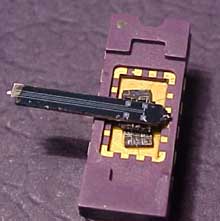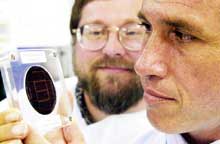This topic covers issues related to energy generation, conversion, transportation and consumption and how the industry is addressing the challenge of energy efficiency in general.
innovations-report provides in-depth and informative reports and articles on subjects ranging from wind energy, fuel cell technology, solar energy, geothermal energy, petroleum, gas, nuclear engineering, alternative energy and energy efficiency to fusion, hydrogen and superconductor technologies.

A wheelchair robot developed by scientists at Coimbra University already has a prototype “capable of navigating without colliding with obstacles by commanded human voice”, as professor Urbano Nunes states, the person with joint responsibility, with professor Gabriel Pires, for the team of professors and students of the Electro-technical Engineering Department responsible for the project.
For the last five years this project has been developed and integrated in degree classes and pos

One of the world’s largest and most successful experimental fusion machines has been safely disassembled and cleared away. In September, staff at the U.S. Department of Energy’s (DOE) Princeton Plasma Physics Laboratory (PPPL) completed the dismantling and removal of the Tokamak Fusion Test Reactor (TFTR), which shut down in 1997 following 15 years of operation. During its experimental life, TFTR set records for fusion performance and made major contributions to the development of fusion as

While electronic circuits and nanomachines grow ever smaller, batteries to power them remain huge by comparison, as well as short-lived. But now Cornell University researchers have built a microscopic device that could supply power for decades to remote sensors or implantable medical devices by drawing energy from a radioactive isotope.
The device converts the energy stored in the radioactive material directly into motion. It could directly move the parts of a tiny machine or could generat

High Level Group for Hydrogen and Fuel Cell
Thank you Madam Vice President, and thank you again, (Ladies and) gentlemen for your attention.
Madam de Palacio has presented to you our concerns in the European Union over Global climate change, energy security and transport. We are committed to achieving sustainable development.
We re-stated our commitment in Johannesburg and are embarking on a comprehensive range of measures. This includes research on the most promisi

It would send and receive faxes and video and have the processing power of a personal computer. The cell phone of the future would be on the market today but for one hitch: the battery.
The technology is available to build cell phones that would make the latest versions — those that allow users to send pictures and play video games — seem almost primitive. But the batteries now used in cell phones are not nearly powerful enough to drive all the fancy add-ons, said Charles Martin, a Univers

UH Solar Cell Research Has Applications for Space Exploration, Clean Cars
New technologies designed to harness the power of the sun may hold the key to successful moon colonies, cheaper and lighter-weight satellites, and cleaner-burning, more efficient car engines.
Solar cells, electronic devices that convert sunlight into useful electricity, would be an important resource for powering future industrial bases or colonies on the moon. Alex Freundlich, research professor of ph